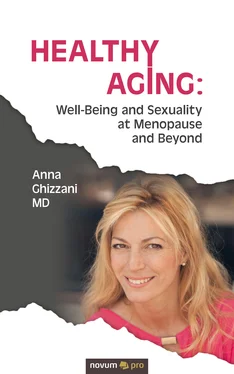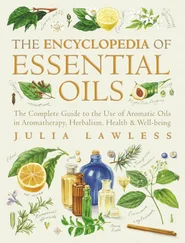Cardiovascular diseases
Cardiovascular pathologies, and in particular coronary disease, are the most frequent cause of death in women. The pathological mechanism is similar to that in men, but with a number of characteristics specific to the female gender, depending on the amount of estrogen3 in circulation, the reduction in which represents an important risk factor. This information is not taken on board by the public at large, and breast cancer, rather than cancer in any other organ, is the event most feared by middle-aged women. This fear is understandable if one thinks of the devastating impact that a cancer diagnosis has for a person, whatever organ is affected, and the special meaning that the breast has for any woman. However, it is not justified by the statistics. Indeed, a cardiovascular event is the most frequent cause of death in women (46% of cases), more than tumors, respiratory conditions, infectious diseases, cerebrovascular events and traumas. After the age of 50, causes of death in women are ischemic conditions, tumors, and neuromuscular degenerative diseases. Progress in the early diagnosis of tumors is improving the chances of survival, and increasing the incidence of ischemic conditions. Up until age 40, ischemic disease is less frequent in women, but after 50 it increases considerably, probably because with menopause one loses the protective effect of estrogen on the cardiovascular system.
3Female sexual hormones produced by the ovarian follicles.
The natural history of cardiac disease in women is different from that in men. Its first manifestation occurs with angina pectoris (chest pain caused by myocardial ischemia), instead of with a heart attack (65% and 35% respectively). The symptoms can remain less severe for years, and indeed women who suffer a heart attack are 7 or 8 years older than men.
After the age of 64, hypertension is the most frequent cause of cardiac stroke. Smoking is also an important risk factor in determining coronary disease and atherosclerosis in women without other health problems. Obesity, diabetes, and an altered lipid profile are factors that worsen damage caused by hypertension and smoking. Obesity by itself does not represent a direct risk for cardiovascular disease, but it does cause metabolic conditions such as hypercholesterolemia, and it worsens hypertension, events which have knock-on effects, contributing to coronary damage.
Oral contraceptives, such as the pill, only very rarely cause non-fatal heart attacks in women without other risk factors, but who are over the age of 40, or in younger women who are carriers of congenital heart disease, malign hypertension and cardiomyopathy. The most serious side effect caused by these drugs, is phlebothrombosis; for this reason, they are advised against in women with obesity and hypertension, or in women with an altered lipid profile4.
4Johansson-Vedin-Wilhelmsson, Myocardial infarction in women in “Epidemiologic Reviews”, vol. 5, 1983, pp. 67–95.
The association between cigarette smoking and coronary ischemic damage is, however, well known. Around 30% of deaths from heart attacks can be ascribed to smoking, which is the biggest independent risk factor that can be changed, both for men and for women, and it correlates directly to the number of cigarettes smoked. Smoking two packets a day increases the risk by 200% compared to a non-smoker, and when smoking is associated with other factors, such as hypertension, the overall risk becomes greater than the mathematical sum of the two components. The risk of developing coronary disease and atherosclerosis (namely damage to blood vessels) remains significant in women who are smokers without other relevant factors, but in this case, too, the synergic relationship of smoking associated with taking oral contraceptives increases the risk of ischemic disease tenfold, compared to women who do not smoke, and who do not take contraceptives5.
5Centers for Disease Control, Smoking and cardiovascular disease, in “MMWR”, 1984, pp. 677–679.
Differences between women and men
Cardiovascular disease is found to be the leading cause of death among women, despite the fact that it is extremely infrequent up until menopause. Ischemic damage, a heart attack, is between twice and four times as frequent in men than in women, but it is not clear what determines this difference; indeed, the higher incidence in men does not seem to be exclusively related to known risk factors (hypertension, body weight, diabetes, physical activity, and cholesterol levels). Indeed, if one looks at the problem from the point of view of the female gender, it seems that the low incidence of cardiocirculatory illness in pre-menopause ages can be put down to the protective effect that estrogen has on blood vessel function. Other female characteristics include a lower propensity to develop hypercholesterolemia and diabetes, together with less stiffening of the peripheral arteries; this latter condition is to be ascribed to the direct action of estrogens on the vascular system, in which they cause arterial vasodilation and relaxation of the vascular muscles, with a resultant lowering of blood pressure. Together with their action to combat atherosclerosis, these constitute a powerful protective effect against hypertension.
The increased risk of cardiovascular disease in postmenopause may be due to hormonal changes and the aging process, although the relationship is not completely clear. In the same way, there is debate over the effect that replacement therapy in menopause has on the cardiocirculatory system, insofar as it has shown positive, negative and neutral effects in the course of many assessments. In any event, although the risk of cardiovascular disease in women increases with menopause, the greater susceptibility of men remains throughout their lives6.
Конец ознакомительного фрагмента.
Текст предоставлен ООО «ЛитРес».
Прочитайте эту книгу целиком, купив полную легальную версию на ЛитРес.
Безопасно оплатить книгу можно банковской картой Visa, MasterCard, Maestro, со счета мобильного телефона, с платежного терминала, в салоне МТС или Связной, через PayPal, WebMoney, Яндекс.Деньги, QIWI Кошелек, бонусными картами или другим удобным Вам способом.












